FINAL SELECTIONS FOR ISEA
INTERACTIVE CITY
We are proud to announce the complete list
of accepted proposals for the Interactive
City theme at ISEA 2006. We are extremely excited
about these pieces and expect them to form an important basis
on which to further experience the Interactive City theme at ISEA
2006.
We received an extremely high number of
submissions for the Interactive City. Each
submission was read by at least five anonymous reviewers and
received at least two formal reviews, some with even more.
We are very thankful for the efforts and feedback from our
international jury in helping make selections for this early
round and acknowledge them at the end of this web page.
|
 |
99 Red Balloons
Jenny Marketou
Katie Salen
|
99 Red Balloons is a live action street game that uses
collective surveillance to explore public anthropology
and hidden geographies. It is a project that proposes
an alternate story, an oppositional one, performed
through play in public space. We propose a situation of
“utopia” where, through the action and interaction of a
community of happy players (agents and super agents), a
mass of 99 red helium balloons are sent up, up into the
sky above Cesar Chavez Plaza and surrounding sites to
take over surveillance of the city. Each balloon is 5
feet in diameter when inflated, outfitted with a small,
hidden wireless camera, and connected to a 60 feet
tether, held and manipulated by players during the game
to control the height and position of the balloon. The
city becomes interactive, lively, visible, imagined,
red, and passionate!
|
|
|
Blue States
Mark Pesce
|
The city occupies two parallel spaces: the objective
space of place and location; and the subjective space
of relation and interconnection. We have maps to
represent objective space; Blue States will offer up a
chance to gather, visualize and permute maps of
relational space.
Blue State generates a data shadow drawn from all
network visible entities as they move through
relational space; entities are recorded and visualized
according to their relation to one another. Instead of
an absolute plot of positions in locative Cartesian
space, the map of relational space portrays the flow of
individuals and the emergent social networks which are
the true inner life of the city.
|
|
|
Call
Germaine Koh
|
In an accessible public place is installed a blank
telephone, resembling those used to make direct calls
to customer-service centres. A sign on or beside the
phone indicates (in the major local languages) that
“When you pick up the phone, you will be randomly
connected with one of a range of community members who
have agreed to receive calls. Your conversation will
not be monitored.” No further instructions are given.
Some two dozen project participants willing to receive
phone calls from strangers in open-ended experiment in
public behavior will previously have been solicited
through local media.
|
|
 |
DIY Urban
Challenge Jonah
Brucker-Cohen
Katherine Moriwaki
|
DIY Urban Challenge is a workshop in
which participants "hack" the streets of San Jose,
creating objects which interject themselves into the
urban fabric, to stimulate new experiences of the city.
During a two day workshop participants will traverse
San Jose detailing points of intersection and friction,
and will use recycled and cast-off materials as well as
wireless technologies to develop objects which can be
installed within the cityscape. Some of the questions
we will ask with this workshop, will center on urban
awareness and possible alternative "services" which
could result in increased interactions between people
in the city.
URL:
http://www.scrapyardchallenge.com
|
|
 |
The Drift Relay
Christina Ray
kanarinka
Lee Walton
|
The Drift Relay is a collaborative psychogeographic
workshop in the form of a 24+hour exploration of San
Jose. Participants will drift through new and familiar
city spaces with a Glowlab guide and a mobile kit of
digital and analog recording tools, contributing to a
collective journey of endurance and discovery. Project
headquarters at ISEA will continually broadcast the
remote group's location and status; attendees and
members of the public may connect with or leave the
roaming mob of documentarians at any time. Data and
artifacts will be returned to the headquarters for
processing and display throughout the duration of the
workshop. Taking the phrase "the city that never
sleeps" to heart, together we'll locate the joys and
difficulties of documenting ephemeral urban experience.
|
|
 |
Fête
Mobile
Marc Tuters
Luke Moloney
Karlis Kalnins
Adrian Sinclair
|
T
he Movable Feast/ Fête Mobile features a robotic blimp
carrying a short-range radio, a wireless file server, a
video camera and an LED message board, as the
centerpiece of a public art intervention. As the blimp
flies through the streets it creates a wireless bubble
of social activity accessible to those within its
immediate proximity through wireless devices. Below the
blimp, the project’s artists interact with the audience
orchestrating the audience’s experience, whilst online,
participants have a bird’s-eye-view of the event thanks
to a wireless video link to the blimp’s on-board
camera.
|
|
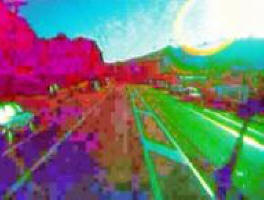 |
Filmmaking robot
Douglas Bagnall
|
The eyes consist of a small computer with a camera and
wifi card mounted upon the front of a public bus
collecting video. When an open wireless connection is
traversed, wthe video is uploaded to the body. For
about 12 hours a day the robot dwells on its memories,
recalling well liked or pertinent imagery, and
attempting to connect it through a sequence of frames,
which is shown as video. Each frame is analyzed to give
20 numbers summarizing its qualities, and these numbers
are treated as coordinates in a 20 dimensional space.
Proximity in this space is used to determine similarity
for the purposes of creating a video sequence. These
numbers are also feed to neural networks which have
been trained to like selections of fine art and images
identified as well-composed by human subjects, and the
response of these networks determines whether the robot
likes an image. At the end of the day, it looks over
its production, and picks out a few minutes to release
as a finished film.
|
|
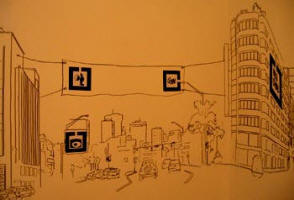 |
Free Network
Visible Network
Clara Boj
Diego Diaz
|
Free Network Visible Network is an urban intervention
project that uses the possibilities of the new
technologies to create new landscapes in the public
space by means of the visualization of the data that
flow between digital networks. It changes our
perception of the world with the “invisible meanings”
that are around us. Free Network Visible Network is a
project that combines different tools and processes to
visualize, floating in the space, the interchanged
information between users of a network. The people are
able to experience how colorful virtual objects,
representing the digital data, are flying around. These
virtual objects will change their shape, size and color
in relation with the different characteristics of the
information that is circulating in the network.
|
|
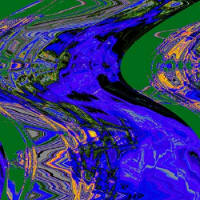 |
Landstream
Olga Kisseleva
|
Land-stream studies the density and the quality of
electromagnetic fields. Using local graffers the team
realizes an in-city fresco with the real time field’s
capturing of EMF signals. Land-stream comprises a term
"stream" which means "flow", or, in the data-processing
terminology - the continuous flow of information in
real time mode. "land" comes from "landscape", because
this project introduces a new category of landscape’s
representation.
|
|
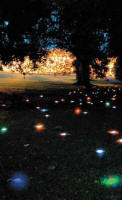 |
LICHTschwarm
Meier Jürgen
|
LICHtschwarm is a interactive approach to urban
lighting and media. LICHTschwarm is a interactive group
of communicating luminaires, which recognizes its
environment through sensor fields. LICHTschwarm starts
a time- and user orientated light interaction. Light
changes with the speed and amount of users. It can
reflect on noise or sounds, time, weather and
surrounding light sources, mobile phones or animals,
cars or birds. Luminaries forming swarms and change
their groupings constantly according changing
conditions. Looking from near, single lights take part
in a big light performance. From further away light is
architecture and architecture is light in a constantly
changing flow.
|
|
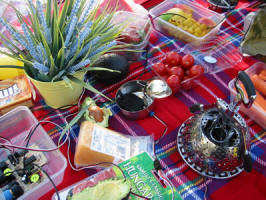 |
LiveForm:Telekinetics
Jeff Mann
|
LiveForm:Telekinetics creates experiences in
transgeographic temporary performance zones, centred
around wireless Internet access points that are now
ubiquitous in the urban landscape. No longer tied to a
terminal screen and keyboard, nomadic groups pack
mobile feasts of sensors, antennas, robotics, food, and
music, and head out on the town. Networked telepresence
picnic parties unfold in vacant lots, roadsides, cafés,
alleyways, bars, and hotel lobbies - wherever bandwidth
is plentiful and security guards scarce. The events are
not meant as entertainment for an audience, but as
experimental and collaborative acts of creativity,
research and development of new social forms, and
interventions in public space.
|
|
 |
Loca
Drew Hemment
Mika Raento
John Evans
Theo Humphries
|
A person walking through the city centre hears a beep
on their phone and glances at the screen. Instead of an
SMS alert they read a message:
“We are currently experiencing difficulties monitoring
your position: please wave your network device in the
air.”
Loca deploys a cluster of interconnected Bluetooth
nodes within inner city urban environments; each node
is built using readily available, cheap parts and is
encased in concrete. Loca can track any Bluetooth
device that the owner has set to visible. Our system
makes inferences based on analysis of the collected
data to guide communication with these Bluetooth users,
for example via unsolicited messages or performers.
Pervasive surveillance has the potential to be both
sinister and positive at the same time. Loca attempts
to equip people to deal with this ambiguity and to draw
their own conclusions.
More information can be found at
http://loca.uiah.fi
|
|
 |
MISSION ETERNITY
etoy.ZAI
etoy.GRAMAZIO
etoy.MONOROM
etoy.HAEFLIGER
etoy.MARCOS
etoy.KUBLI
etoy.NEWTRON
etoy.VINCENT
etoy.SILVAN
etoy.MIR
etoy.STAMBERGER
etoy.ROCK
etoy.ROCKET
etoy.THOMMY
etoy.ZAK
etoy.MAX |
In 2004, etoy.CORPORATION secretly
started to implement M∞ - MISSION ETERNITY - a wireless
technology-driven cult of the dead.
16 etoy.AGENTS from Switzerland, Italy, Spain, Austria,
Germany, Luxembourg and the USA work on a digital /
physical multi user sarcophagus for the information age
bridging the gap between generations as well as the gap
between the world of flesh and the info space of
memory.
At ISEA2006 the dead, usually banned from the living
part of a city, will permeate the festival area and the
town to initiate interaction with the audience and the
citizens of San Jose - asking for asylum in the daily
growing memory of mobile devices and servers worldwide.
By installing the M∞APPLICATION on their cellphones the
ISEA visitors become M∞ANGELS who host the dead and
enable them to exist / communicate forever…
|
|
 |
NOCTURNE
Colin Ives |
Nocturne is an interactive media installation focusing
on animals such as opossums, raccoons and coyotes that
have found successful niches within the urban and
suburban landscape of San Jose. Footage of these
animals is captured using video live traps, feeding
stations, and surveillance equipment. In the gallery,
each captured video plays on a LCD screen scaled to the
creature’s actual size. The video responds to the
presence and actions of the human viewers visiting the
gallery, becoming a mediated exchange between
co-inhabitants of Silicon Valley. Nocturne asks viewers
to reconsider the city of San Jose on the terms of the
other species with whom they share it.
|
|
 |
P2P: Power to
the People Matt
Gorbet
Susan Gorbet
Rob Gorbet
|
P2P is a 30-foot interactive marquee hanging on the
façade of a building in downtown San José. 125 light
bulbs, with 125 corresponding switches just across the
street. By engaging in the everyday unconscious
activity of flipping a light switch, passers-by can
express themselves, forming
any patterns they choose in the hanging web of lights.
Solo interaction blends with group dynamics as messages
from vanity to profanity, from emotion to allegiance,
are constantly created and changed. Ultimately, P2P
encourages dialogue about the future of public
expression in a technology-filled world. What will you
say?
|
|
 |
Paper Cup
Telephone Network
Matthew Biederman
Adam Hyde
|
The Paper Cup Telephone Network
is open and free communication for the people. The PCTN
literally connects you to your friends, family,
clients, co-workers, and even strangers. The calls are
free, the technology is open, and the interface is
intuitive.
While using the latest open softwares, PCTN lowers the
technology threshold for participation. To make a call
simply pick up the cup and talk. If you don’t know the
person on the other end of the line, maybe they know
someone you do. Don’t speak the same language as the
person on the other end? Ask someone on the street to
help you translate. PCTN offers the community a media
they can use to communicate.
Make a call anywhere, anytime. You might not get who
you were after but then again, maybe you’ll like them
anyway...
|
|
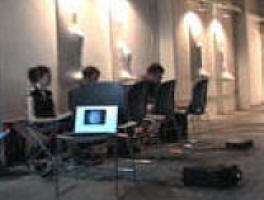 |
Parking Spaces
Mobile Performance Group
|
For this project the Mobile Performance Group (MPG)
investigates one of the most ubiquitous spaces in the
United States, the parking lot. In “Parking Spaces” MPG
will move through the city looking for empty parking
lots to use as raw material to create improvised sound
and image from and as a performance space. The formula
for this performance is as follows; roam the city
searching for parking lots, once an appropriate space
is found record and collect both audio and visual
material from that space. Using only recorded audio and
visual material from that space the performers will
create an improvised audio/visual performance using
custom real-time audio video software. The improvised
performance will be presented, at night, in the same
space the material was found. Interested audience
members can check our site for location updates, call
for location updates or come across our performances by
chance as they and we roam the city.
|
|
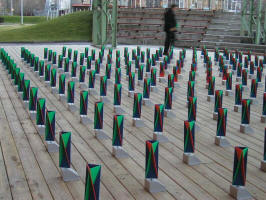 |
Ping Genius Loci
Adam Somlai-Fischer
Bengt Sjölén
|
Ping Genius Loci is built up from 400 radio networked,
solar powered, self sustainable intelligent analogue
pixels, that are placed on a 20 by 20 meters grid.
These pixels function in the bright sunshine, and are
interfacing the people walking in the grid. This
installation explores scales that can be reasonably
designed and built with embedded sensors,
communication, to create programmable sites for natural
interaction in public spaces.
|
|
|
Pioneers
Hitchhiking in the Valley of Heart's Delight
Julie Newdoll
|
Pioneers Hitchhiking in the Valley
of Heart's Delight consists of five life-size cutouts
painted with the portraits of people that were
responsible for advancing the technology that drives
Silicon Valley. These cutouts will be implanted with
small GPS devices and then abandoned in public places
in and around San Jose with a request for passers-by to
deliver them to a prescribed location. Real-time
information about them and their whereabouts will
monitored and reported.
|
|
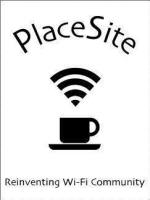 |
PlaceSite
Network: San Jose
Damon McCormick
Sean Savage
|
Project PlaceSite introduces a new way of using
wireless networks -- to create digital community
services by, for and about people who are together in
the same physical place.
PlaceSite is an open platform for a new breed of Web
service tied intimately to physical places. It lets
people share information locally, apart from the global
Web.
PlaceSite is built upon what already exists -- users
don't need to install new software or purchase new
hardware. It also enables location-based services
without relying on participation by cellular carriers
or Internet service providers.
|
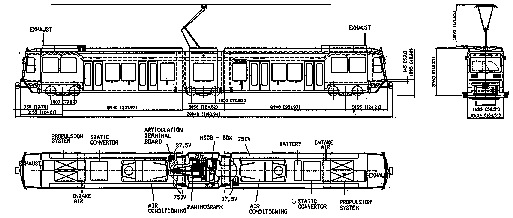 |
Saint Joe
John Klima
|
"Saint Joe" is a hyper-narrative
that unfolds within the landscape of VTA light-rail
system. Participants can board the train at any stop,
at which time using their mobile phone, they can dial a
provided number to enter their origin, and their
destination. As the participant's voyage commences, a
dynamic audio history unfolds, referencing a variety of
landmarks along the way. The landmarks however, are not
your standard tourist fare. Locations, buildings, and
vistas both mundane and curious are chosen to carefully
weave a semi-fictitious tale of the city. Drawing from
actual San Jose history, archived newspapers, police
records, and local folklore, an audio and visual
construction is elaborated while the viewer travels
from station to station.
|
|
 |
WITHDRAWN
San Jose Instant
Film Festival
Andrea Moed
|
During ISEA 2006, your digital
camera, mobile phone or brilliant idea can be your
ticket to instant cinematic greatness. How do you get
there? Like any budding moviemaker, you volunteer your
skills—in storytelling, visualizing or sound
recording—and team up with other folks who do the rest.
There's just one catch: you'll have to keep it SHORT.
Become an auteur by creating an instant screenplay on
the SJIFF website. Visual types with cameraphones can
sign up to receive shooting assignments via SMS. Want
to be a voice actor or sound recorder? Sign up for
sound assignments and record them by leaving us a
voicemail. Oh, one more thing: Until your complete
movie premiers on the website, you probably won't know
who the other members of your film crew are or how they
interpreted their assignments. So roam the city and
follow your muse, be it Hitchcock, Kurosawa or
America's Funniest Home Videos. What emerges will give
a whole new meaning to the phrase "surprise ending."
|
|
 |
SimVeillance:
San Jose
Katherine Isbister
Rainey Straus
with the support of:
Georgina Corzine
Chelsea Hash
|
Are you being watched as you
travel the streets of San Jose? Probably--our everyday
lives are increasingly captured by cameras in public
spaces. Simveillance:San Jose puts a spin on this
phenomenon, using footage from surveillance cameras
mounted in a San Jose public square as the basis for
crafting 'sim' people that wander a virtual version of
the same square, within the game The Sims 2. You might
find yourself on screen, as the artists will update the
piece to incorporate people who've passed by during
ISEA. Consider the implications and come find your Sim
self!
|
|
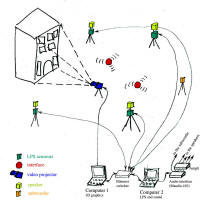 |
WITHDRAWN
SKIN-PÔ
Marc Fournel
|
SKIN-PÔ proposes an interactive environment integrated
in urban space, such as a public square. People will be
able to interact with the visual and audio elements of
SKIN-PÔ via physical wireless interfaces (balls and
other objects of different forms) which will control
video projections on buildings and the creation of
distributed sound in the square. SKIN-PÔ explores and
confronts the different modes of appropriation of our
architectural space. SKIN-PÔ will make us take a
distance, it will make us take a changed perspective
toward our condition as urban actor. SKIN-PÔ aims at
the democratization of the gesture of creation and
invites citizens to appropriate their urban space.
|
|
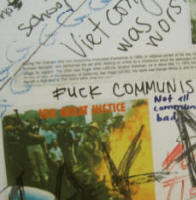 |
Social Memory
Columns Derek
Lomas
|
Five 8’ high by 2’x2’ square white wooden Memory
Columns are placed throughout the metropolitan area,
each seeded with the same text and imagery. These
Memory Columns induce passerby dialogue conducted via
Velcro-ed permanent markers. A physical and virtual
social interaction develops around each column, as
thoughts and sentiments flowing by are deflected from
their usual path and are projected onto the column.
After a 3 day exposure period, each column will have
effectively captured a snapshot of the local collective
memory. By deploying multiple columns within different
parts of San Jose, we are able to probe the various
cultural consciousnesses that flow throughout the city.
|
|
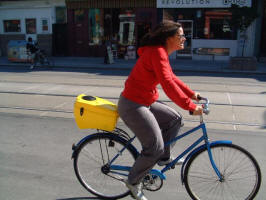 |
SOUNDBIKE
Jessica Thompson
|
SOUNDBIKE is a portable sound piece that uses
motion-based generators mounted to an ordinary bicycle
to broadcast the sound of laughter as the bike is
pedaled through the urban environment. The laughter is
generated by playing sequences of short source clips
that start when the bike reaches a cruising speed and
then respond to the bike's velocity. The piece is
exhibited by loaning the bike on an honor system. By
broadcasting sound directly as a result of his or her
motion and gesture, the rider simultaneously occupies
the role of controller, performer and audience,
becoming part of the acoustic ecology of the city
through technological intervention.
|
|
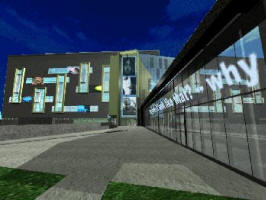 |
SPECFLIC
Adriene Jenik
|
SPECFLIC is an instance of
speculative distributed cinema: a cinematic form which
envisions & performs our near future through the lenses
of our current technological landscape. Focusing
primarily on the changing state of public institutions,
SPECFLIC: version 2.0 San Jose will be experienced
throughout the Dr. Martin Luther King, Jr. Public
Library.
SPECFLIC takes advantage of cutting edge transmission
and display technologies to expand a critical dialogue
(begun in speculative fiction literature) about the
social effects of these very technologies. Throughout
the piece, the performers reflect the ways in which we
adapt our gestures, languages, and styles of
communication to the technologies we use.
Over the course of the durational performance, SPECFLIC
performers improvise their characters' activities
within an overall narrative arc. Community-produced
text and photo streams merge with the site-specific
performance to stimulate creative expression and
critical thought concerning our shared future.
|
|
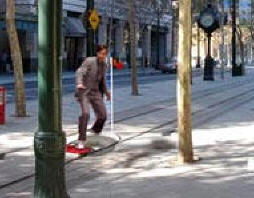 |
SURF
Heiko Hansen
|
The project SURF is an extension of the work TRAIN, a
series of working prototypes installed on existing,
abandoned or partly unused railway tracks. The
installation consists of multiple vehicles that
resemble the design of a surf board. The vehicles can
be freely placed by the public audience on the tracks
of the San Jose Light Rail system and operated by
simply stepping onto it. The electronic surf board
accelerates by leaning forwarded and stops by leaning
backwards or jumping off.
|
|
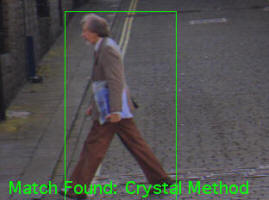 |
SVEN
Amy Alexander
|
"SVEN” (Surveillance Video Entertainment Network) is a
system that can be set up in public places - especially
in situations where a CCTV display might be expected.
The system can be configured for either a mobile unit
or stationary location, and consists of cameras,
monitor, computers, speakers and software. The software
consists of a custom computer vision application that
tracks pedestrians and detects their characteristics,
and a real-time video processing application that
receives this information and uses it to generate music
video-like visuals from the live camera feed. The
resulting video and audio are displayed on a monitor in
the public space, interrupting the standard security
camera type display each time a potential rock star is
detected. The idea is to humorously examine and
demystify concerns about surveillance and computer
systems not in terms of being watched, but in terms of
how the watching is being done - and how else it might
be done if other people were at the wheel.
|
|
 |
Traffic Island
Disks Saul Albert
Michael Weinkove
a.k.a The People Speak
|
Traffic Island Discs is a radio show about music,
people and spaces. We roam the streets looking for
people wearing headphones, stop them, and interview
them while recording whatever they are listening to.
The result is a tour of an area of the city, heard
through people's personal tastes and rhythms.
For ISEA 2006, Traffic-Island Disks will be
experimenting with other parts of the radio
spectrum, webcasting live from specific locations in
San Jose that provide wireless internet access, as
well as archiving and re-publishing those streams on
the local wireless network, building up a repository
of street-level soundtracks to the city.
|
|
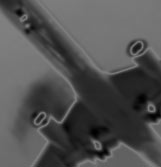 |
Tripwire
Tad Hirsch
|
Tripwire is an "urban defense" system that alerts
residents to hazardous noise events. A series of remote
sensing stations continuously monitor sound levels in
the city. Project participants who register their cell
phone numbers with the service receive phone calls
and/or text messages whenever excessive sound levels
are detected. These calls inform participants of the
location, intensity, and probable cause (determined by
signal analysis) of the noise event. Data from the
project is archived in a public database - available
via the project website - that enables amateur
participation in interpreting noise data and
determining noise abatement policy.
|
|
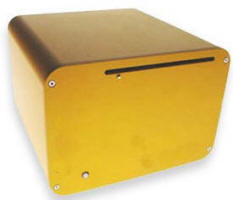 |
WiFi ArtCache
Julian Bleeker
|
The ArtCache is a free floating 802.11 WiFi node and is
deliberately not connected to the public internet.
WiFi.ArtCache consists of a WiFi node containing
digital art objects retrieved by attendees via an
embedded access point. These art objects are
interactive and programmed in Flash or Processing in
such a way as their behaviors and interactivity can be
articulated based on the physical and virtual activity
of other attendees who are interacting with the node's
art objects. For instance, each art object can access
variables and functions that specify such things as how
many people are currently interacting with the ArtCache
and thus alter characteristics — color, tempo, shapes,
animations — based on a range of variables that,
ultimately, indicate the kind and level of social
activity in and around the ArtCache.
|
|
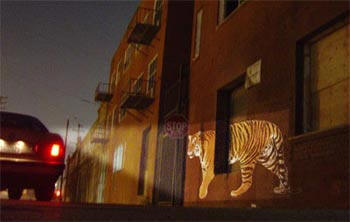 |
wildlife
Karolina Sobecka
|
At nighttime projections from moving cars are shone on
the buildings in the industrial/abandoned part of town.
Each car projects a video of a wild animal. The
animal’s movements are programmed to correspond to the
speed of the car: as the car moves, the animal runs
along it, as the car stops, the animal stops also.
Aggressive driving is reflected in the aggressive
behavior of the animal. The animals are avatars of the
drivers, who, enclosed in their bubble of safety, are
separated from the stark and dangerous world of urban
reality, as being in a different universe. The
projections both expose the starkness of the urban
landscape, and transform it into a world of dark
fantasy.
|
|
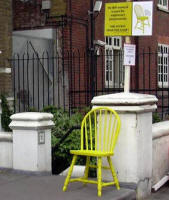 |
Yellow Chair San
Jose Anab Jain
Tom Jenkins
|
Two local households from different neighborhoods in
San Jose will to extend their wireless internet
connection beyond the confines of their home to the
public space outside. The two chairs will sit in the
path of directional antennas, creating a spatial,
visible area of connection. These two nodes will also
be able to communicate with each other through a
central server and exchange files, conversations and
services. Thus the person sitting on the chair will
access the world wide web as well as the yellow chair
network. This re-appropriation of existing technology
will create new channels of day-to-day contact for
people in the city, and might lead to a more
significant socio-political debate depending on the
location of the family in the city.
|
INTERACTIVE CITY JURY
includes jury members from both early and final rounds
of reviews
Eric Paulos (chair)
|
Adrian David Cheok
Amanda McDonald Crowley
Amy Franceschini
Anne Galloway
Anne Nigten
Annika Waern
Anthony Burke
Atau Tanaka
Barbara London
Ben Hooker
Bill Gaver
Bill McDaniel
Chip Lord
Chris Beckmann
Christiane Paul
Clay Shirky
David Cranswick
Ed Osborn
Elizabeth Goodman
Ellen Pau
Fabian Wagmister
Giselle Beiguelman
Golan Levin
Howard Rheingold
Ian Clothier
Jane McGonigal
Jeffrey Huang
Jill Miller |
Joel Slayton
Jonah Brucker-Cohen
Julian Bleecker
Jussi Holopainen
Ken Anderson
Marc Tuter
Matt Jones
Matthew Chalmers
Michael Connor
Michele Chang
Michelle Kasprzak
Mike Liebhold
Mirjam Struppek
Paul Dourish
Peter Droege
Richard Lowenberg
Ron Golden
Sara Diamond
Scott Klemmer
Soh Yeong Roh
Steve Benford
Susan Hazan
Tad Hirsh
Teri Rueb
Tom Igoe
Tom Jenkins
Trond Nilsen
Warren Sack |
Also many thanks to Mamie Rheingold for
organizational assistance with the Interactive City committee
and artists.
|